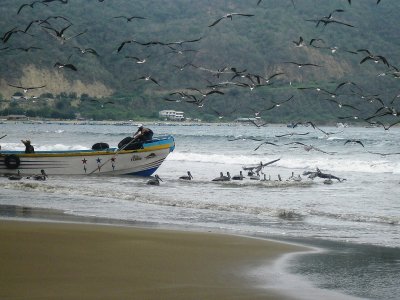By Nuria Estrella Santos
Puerto Lopez and the Transit of the Whales
 Every year the arrival of the humpback whales changes the lives of Puerto Lopez, a fishing village in the south central coast of Ecuador. The whales migrate from the polar regions to warm equatorial Pacific waters for mating and reproduction. Puerto Lopez, has an urban population of 8,000 inhabitants and is situated within the Machalilla National Park. It is mainly a fishing village, which for nearly two decades has developed a growing tourist activity around whale watching and visits of the Machalilla National Park (Photos Nuria Estrella Santos unless indicated otherwise).
Every year the arrival of the humpback whales changes the lives of Puerto Lopez, a fishing village in the south central coast of Ecuador. The whales migrate from the polar regions to warm equatorial Pacific waters for mating and reproduction. Puerto Lopez, has an urban population of 8,000 inhabitants and is situated within the Machalilla National Park. It is mainly a fishing village, which for nearly two decades has developed a growing tourist activity around whale watching and visits of the Machalilla National Park (Photos Nuria Estrella Santos unless indicated otherwise).
In this context, the role of tourism as one of the main factors for the development of Puerto Lopez, it is undeniable, but tourism brings some perverse effects: urban congestion, social changes, the accumulation of all types of waste, damage to ecosystems and biodiversity.
Until now, the tourist activity in Puerto Lopez contributes little to conservation. In a regular operation, for example, where a tourist boat gives one or two snacks to between 16-20 tourists on board the whale watching tours or to Silver Island (Isla de la Plata), are generating at least 30 disposable plastic cups daily. The tourist season lasts about 4 months and there are at least 20 registered vessels engaged in whale watching tours and tours to the Isla de la Plata, even apart from other boats that carry out tours illegally.

To make a conservative estimate, assume that during the four months of high season from June to September, 20 ships make an average of 7 trips per month each. This translates into nearly 20,000 disposable plastic cups. The picture is not complete without the soft drink bottles that are at least 2 per transaction ... Thus, considering that 12 tons of garbage are produced daily in the canton of Puerto Lopez, in the peak tourist season this increases by between 2 and 4 tons of waste, mainly plastics.
While waste is a worldwide problem, in developing countries like Ecuador, this is heightened even more, by population growth, lack of waste treatment, lack of resources, poverty, poor health, increased consumption, lack of management as well as institutional weaknesses, among others. The case of Puerto Lopez confirms this fact. There is very little awareness among the population and the small scale and industrial fisheries about pouring waste into the sea. Indeed, the population has turned some rivers and empty space into landfills, etc.
In a natural protected space, such as the Manchalilla National Park, the sum of these unsustainable practices could jeopardize the conservation of the environment and alter the ecology of the area's flagship species such as whales, turtles and birds.
What is not in the garbage bin ...
The Municipality of Puerto Lopez collects approximately 70% of the waste generated in the county so far without treatment and heaps it up at the disposal site. The system has its weaknesses due to a lack of resources and management. The waste management is currently subsidized by 86%.
The garbage, which is not collected or which people have inappropriately thrown away, accumulates in rivers, streams, and vacant lots. Sooner or later part of this debris reaches the sea, carried by rivers, rain or wind. The artisanal & industrial fishing sectors' waste is often discharged directly into the sea. This is compounded by the garbage which accumulates on the beaches from tourism and unloading activities of the fisheries.
Waste not only creates health risks for people, but also for the lives of marine animals, mainly turtles and sea birds which die from accidental ingestion of residual waste, mainly plastics and discharged netting materials.
The trash on the beaches, which is brought up by the tide and the wind directly, is also a problem. It is an aesthetic problem that gives a bad image to people and therefore affects tourism; but it is also a risk to the public and the visitors, who can suffer accidents by the remains of cans or glass, and constitutes a danger for children playing with garbage on the beach.
What is in our hands.
Faced with this problem and the necessity to act, the project "Support to the Integrated Waste Management in Puerto Lopez, Jama and San Vicente" was set up. The project is funded by the European Union and implemented by the Foundation Santiago of Guayaquil. One of its priority objectives is to influence the population toward more responsible behaviour in managing waste.
In the design of strategies to involve people the RecicleARTE competition was devised to coincide with the whale watching season. The competition aimed at generating awareness among the public about the problems of garbage and spreading the habit of recycling. The idea was to build sculptures of whales, the iconic species of Puerto Lopez, made from recycled material.
Mergers between science and art are not altogether new, but the focus in each case is different, the ultimate goal is to find a new means of expression and a way to sensitize people on environmental issues.









